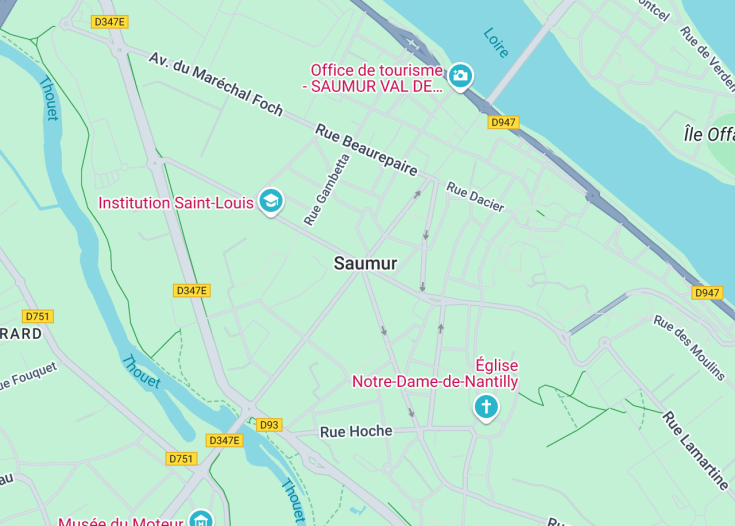Nestled along the banks of the Loire River, Saumur is famous for its enchanting chateau, distinguished equestrian tradition, and its role in winemaking, particularly its sparkling wines. This picturesque town offers a blend of rich history and natural beauty, drawing cultural enthusiasts and nature lovers alike. Saumur’s historic town center, with its cobblestone streets and traditional French architecture, invites visitors to step back in time while enjoying modern French culture.
For a memorable experience, visit during the Grandes Tablées du Saumur-Champigny festival in August, where wine and local gastronomy are celebrated in a lively outdoor setting.
Don’t miss exploring the National Riding School or attending a performance by the world-renowned Cadre Noir horsemen, offering a unique glimpse into French equestrian excellence.
Top things to do & see in Saumur
Select the following sights and activities to discover best tickets and tours available in Saumur.
Saumur: A Historical Jewel by the Loire
| Country | France |
| Time in Saumur | GMT+1 |
| Language spoken | French |
| Population | 27,523 (INSEE, 2021) |
| Currency | Euro (€, EUR) |
| Airports |
|
Saumur, a charming town in the Pays de la Loire region of France, is celebrated for its rich history, distinctive chalk-white stone buildings, and revered wine production. Nestled along the banks of the River Loire, Saumur is crowned with a majestic château which stands as a prime example of the early French Renaissance architecture. The town’s history is deeply influenced by the river providing a critical trading route, which has been responsible for prosperity since the medieval era.
The town’s geographical positioning on the Loire and its high-quality terroir makes it a pivotal area in the production of some of the finest wines in France, including the sparkling Saumur Champigny. Saumur is also famous for its equestrian tradition and hosts the prestigious École Nationale d’Équitation, known for training the famous Cadre Noir horses. Additionally, Saumur plays host to several cultural festivals throughout the year which attract visitors from across the globe, notably the Grandes Tablées du Saumur Champigny, where wine lovers gather to celebrate the new vintage.
Visitors to Saumur can take guided tours of its iconic château, explore several mushroom museums due to the town’s significance in mushroom cultivation, or relax in one of the many quaint cafes lining the historic town center. The combination of its scenic beauty, historical sites, and cultural vibrancy makes Saumur a must-visit destination in the Loire Valley.
Where is Saumur?
Saumur is located in the western part of France, nestled along the Loire River in the scenic Loire Valley.
Distances:
| Route | Distance by car | Time by Car |
|---|---|---|
| Paris to Saumur | 174 mi / 280 km | Approx. 3 hours |
| Nantes to Saumur | 120 mi / 193 km | Approx. 2 hours |
| Tours to Saumur | 40 mi / 64 km | Approx. 1 hour |
What is Saumur famous for?
Saumur is renowned for its incredible château, exquisite wines, and the prestigious École Nationale d’Équitation, where the elite Cadre Noir horse riders are trained.
History
Prehistory-10th Century: Early Settlements
From prehistoric times, the region around Saumur, nestled along the Loire River in France, was occupied by various tribal groups appreciating its strategic location. Archaeologists discovered tools and remnants that testify to its long-standing human activity, paving the way for its historical journey.
10th Century-15th Century: Medieval Flourishing
The formal foundation of Saumur is documented in the 10th century when the Count of Blois built the first castle here, a precursor to the renowned Château de Saumur. Over the centuries, the town became an important military and economic center in the Anjou region, known for its vigorous trade. The Middle Ages were a golden period for Saumur, witnessing the construction of many of its iconic structures, including fortifications and churches that stand to this day.
16th Century-18th Century: Renaissance and Enlightenment
During the Renaissance, Saumur experienced an intellectual and architectural revival. It established itself as a hub of Protestant scholarship with the founding of the Saumur Academy in 1599, attracting scholars from across Europe. The era of Enlightenment didn’t slow the cultural ascendance of Saumur, despite the religious tensions that occasionally flared due to its Protestant leanings in predominantly Catholic France.
19th Century-20th Century: Industrial Expansion and Modern Challenges
The 19th century saw Saumur evolving with the times, embracing the industrial revolution, but also retaining its historical charm, which started attracting tourists. The two World Wars had significant impacts on Saumur, with the town being occupied during both conflicts. Post-World War II, Saumur worked on rebuilding and preserving its cultural heritage, managing to retain its historical significance and charm.
21st Century: Contemporary Developments
Today, Saumur continues to thrive as a town of historical significance and as a center for tourism and wine production. Preservation efforts ensure that its rich history is celebrated, while incorporating modern amenities and infrastructure for its residents and visitors.
Visit Saumur
What to see and do in Saumur
Exploring Saumur offers a blend of historical discovery and modern enjoyment. Key attractions include:
- Château de Saumur: Originally built in the 10th century and later transformed into a majestic castle by the Dukes of Anjou.
- National Riding School: Known for its elite cadre of riding instructors and impressive displays of horsemanship.
- Museums: The Musée des Blindés, showcasing military tanks, and the Musée du Champignon, offering insights into mushroom cultivation.
- Local Vineyards: Saumur is famous for its sparkling wines; visiting local vineyards for tastings is a must for enthusiasts.
- The Loire River: Ideal for riverboat cruises that provide unique views of the town and its landscapes.
Festivals in Saumur
Saumur comes alive with various events throughout the year. Noteworthy among them:
- Anjou Vélo Vintage: A retro-themed cycling event held annually in June that brings together cycling enthusiasts dressed in vintage attire.
- The Saumur Champigny Wine Festival: Celebrated in August, this festival highlights the region’s wine production with tastings and entertainment.
- Journées du Patrimoine: In September, Saumur opens up its historical buildings and sites to the public, many of which are normally closed to visitors.
Best time to visit Saumur
The best time to visit Saumur is from late spring to early autumn (May to September) when the weather is most favorable for exploring the outdoors and the full schedule of local events and festivals can be experienced.
Is Saumur worth visiting?
Saumur, with its rich tapestry of historical sites, cultural events, and natural beauty, offers something for every traveler. Highlights include the majestic Château de Saumur and the unique museums dedicated to military armory and mushrooms. Wine enthusiasts particularly will find the vineyard visits enlightening.
However, those seeking modern city life might find Saumur a bit quiet. The town’s relatively tranquil pace and its focus on historical and cultural preservation could be less appealing for some. Overall, for those interested in history, culture, and nature, Saumur is unquestionably worth a visit.









